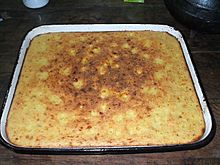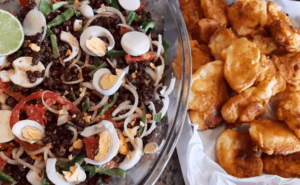Paraguayan cuisine facts for kids
The cuisine of Paraguay is a mix of delicious dishes and cooking styles from Paraguay. It's greatly influenced by the Guarani people, who were the first inhabitants. It also blends with Spanish cuisine and ideas from countries like Italian cuisine and Portugal. This special mix of Spanish and Guarani traditions is very important in Paraguay's history. Many food traditions in the region started in Asunción, the capital city. People from different backgrounds, including Guarani, Spanish, and mixed-race people, shared their cooking knowledge.
In 2017, Paraguay's Ministry of Culture officially recognized some traditional foods as Intangible Cultural Heritage. This means they are important parts of Paraguay's culture that should be preserved. These foods include vori-vori, locro, Paraguayan soup, and jopara (a mix of beans and locro). Their recipes and the knowledge of how to make them have been passed down through families for generations.
Contents
How Paraguayan Food Began
Long ago, before Europeans arrived, the Guarani people ate wild animals and corn bread. They used starch and animal fat in their cooking. However, they didn't know about milk, beef, cheese, or eggs.
When the Spanish arrived in 1537 and founded Asunción, they met the Carios, a group of Guarani. This was the first time Spanish and Guarani cooking traditions started to mix. Soon after, cattle (cows) were brought to the area. This was a big change! For example, the Guarani used to roast wild meat on a stick. Now, they could use beef. This is why many Paraguayans love roasted meats, especially on Sundays.
Asunción is often called the "mother" of gastronomy in the Río de la Plata region. This is because an expedition from Asunción, which included Spanish people, young Paraguayans, and Guarani, later founded Buenos Aires. This expedition also brought cattle to the Pampas region, which helped spread new food traditions.
Food in Colonial Times
Paraguayan food is a unique blend, not just Guarani. It grew from the mix of Spanish cooking and the Carios-Guarani traditions. This happened especially in Asunción and nearby towns like Tobatí, Altos, and Areguá. These towns show how Paraguayan culture developed away from other influences, like those of the Jesuits.
The Carios-Guarani people hunted, fished, and grew grains. They had their own cooking tools and methods. When the Spanish arrived, they brought new ingredients in 1556, like beef, sheep meat, milk, eggs, and cheese.
So, traditional Guarani ingredients like corn, cassava (manioc), pumpkin, and sweet potato were mixed with Spanish ingredients. This blend created many of the typical Paraguayan dishes we still enjoy today. These foods often use cassava, corn, cheese, milk, and meat.
Modern Paraguayan Cuisine
After Paraguay became independent, its unique mixed cuisine became even stronger. People continued to combine Guarani knowledge with new cooking tools and methods from the Spanish. During the time of leaders like Carlos Antonio López and Francisco Solano López, people made the most of all the country's products. They even found ways to reuse meats in many different recipes. Cassava and corn were very common ingredients served with meals.
After the Great War in the late 1800s and early 1900s, more immigrants came to Paraguay, especially from Italy and Germany. These new arrivals brought their own food traditions, like pastas, desserts, drinks, and cold cuts. These foods became part of modern Paraguayan cooking.
Paraguayan cuisine shares some common ingredients with other American countries, such as corn, cassava, peanuts, and beans. But because of its unique mix of Guarani culture and European influences, it has a special flavor. It shares more similarities with countries in the River Plate Region. Popular items like Chipa and Tereré have spread across the southern part of South America due to people moving around.
In 2017, the Ministry of Culture declared several traditional Paraguayan foods as important cultural heritage. These include Vori-Vori, Locro, Sopa Paraguaya, and Yopará. This declaration helps make sure these recipes and the knowledge to make them are passed down to future generations.
Main Ingredients
Meat, vegetables, manioc (cassava), maize (corn), and fruits are common in Paraguayan cooking. Barbecuing, known as Asado, is a popular way to cook and a fun social event. Many dishes are made with corn, milk, cheese, and meat. Fish caught from rivers are also often eaten.
There are about 70 different kinds of chipa, which is a type of cake or bread. Most chipas are made from manioc flour (from cassava) and cornmeal.
Popular Dishes

- Chipa is a bread made with manioc, egg, and cheese. In Argentina, it's called chipá, and in Bolivia, cuñapé.
- Chipa Guasú is a cake made with corn kernels. It's a very common Paraguayan food, often served with asado.
- Chipa so'o is another kind of chipa.
- A traditional kiveve is made with pumpkin, water, salt, oil, onion, milk, sugar, corn flour, and fresh cheese.
- Lampreado, also called Payaguá Mascada, is a fried cake made from manioc flour.
- Mazamorra is a cooked corn mush dish.
- Mbaipy-so-ó is a corn pudding with meat.
- Mbejú is a starch cake and a basic food in the Paraguayan diet.
- Milanesa is a breaded piece of meat, often fried or baked.
- Authentic Paraguay cheese is a special cheese from Paraguay.
- Parrillada is a dish of meat cooked over hot banana leaves and coals.
- Pira caldo is a fish soup, a traditional part of the cuisine.
- Sopa paraguaya literally means "Paraguayan soup," but it's actually more like a cornbread. It's made with corn flour, pig fat (lard) or butter, cheese, and milk. It's a spongy cake, full of calories and protein, and is the national dish of Paraguay.
- Soyo is a thick soup made from meat crushed in a mortar, seasoned with different spices and vegetables.
- Vori vori is a thick, yellow soup with small balls made of cornmeal, corn flour, and cheese.
Sweet Treats
- Cakes come in many different kinds.
- Kosereva is a common candy made from the hard skin of a sour orange, cooked in black molasses. It has a sweet and sour taste.
- Mbaipy-he-é is a dessert made with milk, molasses, and corn.
- Dulce de leche means "sweet milk." It's a creamy caramel-like spread used to fill cakes, spread on toast, or with other baked goods.
Drinks
Terere is the national drink of Paraguay. It's a cold herbal tea. Fruit juices and soft drinks are also popular. Beer and wine are widely available. Pilsen is a very popular beer brand. Caña is an alcoholic drink made from sugarcane juice, and mosto is a non-alcoholic version.
Cocido is a hot tea made from yerba mate and sugar, cooked in a pan with burning coal. The liquid is then filtered with hot water. You can drink it plain or with milk. Cocido is dark brown, like black coffee, and is often enjoyed with chipa or mbejú.
Images for kids
-
Asado with sausages.
See also
 In Spanish: Gastronomía de Paraguay para niños
In Spanish: Gastronomía de Paraguay para niños



